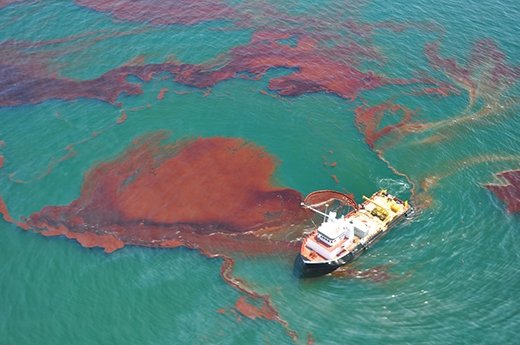by Scotia Code
What does your dog, your hairbrush, and your mom’s nylons all have in common?
All of them can be used to clean up oil spills.
We’re going to take a short break from your regularly scheduled conservation programing for a quick science experiment to take a look at what materials are the best at absorbing oil. This will all make sense in a second, I promise.
I actually already did the science for you, so you don’t have to get your hands messy, but you can follow along if you want! You might have even already done this experiment in a chemistry class. If you want to try it out for yourself, you’ll need a few bowls of water, a few cups of oil, a scale, and some absorbent materials to test. A few common materials are newspaper, cotton, wool, and if you feel like getting fancy you might try feathers or coconut husks. Measure out a set amount of material to test (maybe 10 grams of each material), and pour on a set amount of oil per bowl of water (around 100 grams). Now, take your material and see how much oil you can collect from the top of the water. When you think your material can’t absorb any more oil, weigh it again and see the difference in weight. That change in weight is the weight of oil the material has collected. Now, predictably, paper wasn’t super effective. You probably found that wool and cotton were the most effective materials.
Now, if you take a couple steps back from your kitchen sink, and imagine this on a much, much bigger scale, you can realize you’ve basically replicated an oil spill.

As it turns out, natural fibers are an extremely effective tool to help clean up oil spills. Fur and hair are both natural fibers that are not only absorbent, but also adsorbent. Quick chemistry review: There’s a difference between absorbency and adsorbency! Absorbency is when a material is able to soak in or intake liquid easily. Adsorbency is actually when a material lets a liquid cling to the surface, making a thin film of the surface of the material. Hair is special because it is not only absorbent, but also adsorbent. So when you shower in the morning, your hair doesn’t only soak up the water, but water also clings to the surface of your hair.
Unfortunately, this also happens to animals’ fur in oil spills. If you think about it, this makes sense. Think of all of the heartbreaking images after the BP oil spills of the animals with oil stuck in their fur and feathers.

Now, what can we do with this knowledge?
Looking forward, hair and fur trimmings are low-tech, cost-effective, and efficient method of cleaning up oil. There’s a nonprofit called Matter of Trust in San Francisco that you can even mail your hair to. They collect thousands of pounds of human and animal hair to clean up the thousands of oil spills that happen each year. To read more about the project, look here: http://matteroftrust.org/297/clean-wave-program. Several hair salons and pet shelters have also partnered with the project to collect hair and fur from customers.
What do they do with the hair?
Well, they can make mats and “hairbooms,” which are actually nylons or pantyhose stuffed with hair and fur, that look like long pool noodles. These can be used to clean up oil, and also can be re-used. According to their website, “Just one pound of hair can absorb one quart of oil in one minute, and hair mats can be wrung out and reused up to 100 times.”


So, how can you help?
Well, clean out your hair brush, your dog’s hair brush, and find any spare nylons to donate, and put it in a box addressed to:
Matter of Trust
995 St. Germaine Ave.
San Francisco, CA
94114, USA
While it is mainly large oil spills like BP that get national attention, there can be even several hundred oil spills that occur in a year and go largely unreported. According to ITPOF, the International Tankers Owners Pollution Federation Limited, the “total amount of oil lost to the environment through tanker incidents in 2016 was approximately 6,000 tonnes.” So, even if it’s not making the news, your contribution is still being used!


